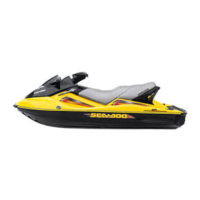
Do you have a question about the SeaDoo RXP 4-Tec Supercharged and is the answer not in the manual?
| Supercharger | Yes |
|---|---|
| Manufacturer | Sea-Doo |
| Model | RXP 4-Tec Supercharged |
| Category | Personal Watercraft |
| Fuel Type | Gasoline |
| Cooling | Closed-loop cooling system |
| Fuel Capacity | 15.9 US gallons (60 l) |
| Width | 48 inches |
| Seating Capacity | 2 |
| Oil Capacity | 3.5 liters |
| Storage Capacity | 10.7 US gal |
Welcomes the new owner and emphasizes safety for responsible operation.
Lists essential safety checks and guidelines before operating the watercraft.
Covers essential preparations, gear, and items to bring for operating the watercraft.
Strategies for preventing collisions with other watercraft and objects.
Guidelines for responsible and safe operation, respecting limits.
Operator's responsibility for passenger safety and awareness.
Techniques for handling the watercraft and towing safely.
Explains right-of-way rules and general boating etiquette.
Explains the use of buoys and markers for safe navigation.
Common hand signals used for waterskiing communication.
List of websites for regulatory information and Sea-Doo resources.
Where to find the watercraft's registration number.
Explains Hull Identification Number (H.I.N.) and Engine Identification Number (E.I.N.).
Covers handlebar, throttle, start/stop, VTS, and information center.
Details glove box, fuel cap, storage covers, and latches.
Covers seat features, grab handles, baskets, eyelets, and cleats.
Jet pump, reverse gate, water intake, and fuses.
Battery, side vanes, oil dipstick, and caps.
Ski/wakeboard post and rack.
Steps for safely fueling the watercraft.
Specifies recommended fuel types and octane ratings.
Details on recommended engine oil and checking oil level.
Information on recommended coolant and checking coolant level.
Recommended inspection after the first 10 hours of operation.
Inspecting the hull for damage.
Inspecting and cleaning the jet pump water intake.
Checking and draining the bilge.
Verifying battery cable tightness and condition.
Checking fuel tank and straps.
Checking for leaks in the engine compartment.
Checking the engine oil level.
Checking the engine coolant level.
Checking steering operation for free movement.
Checking throttle lever operation.
Checking reverse gate operation.
Checking VTS operation for nozzle movement.
Ensuring compartment covers and seat are closed and latched.
Ensuring rack and wakeboard are properly secured.
Checking operation of safety lanyard and start/stop button.
Checking exhaust manifold water flow in cold conditions.
Explains how the propulsion system works.
Operation of neutral and reverse gears.
Adjusts nozzle angle for optimal handling and performance.
How the handlebar controls the watercraft's direction.
Explains the O.P.A.S. system for steering assistance.
General boarding precautions.
How to board from a dock or in shallow water.
How to board in deep water.
Specific precautions when using a wakeboard rack.
Basic cleaning and maintenance after operation.
Special care for operation in foul or salt water.
Flushing the exhaust cooling system to prevent corrosion.
How the monitoring system alerts the operator to faults.
Steps to take if the engine overheats.
Actions to take for low engine oil pressure.
Cleaning the jet pump intake and impeller.
Procedure for handling a capsized watercraft.
Steps to take if the watercraft is submerged.
Actions for a water-flooded engine.
Steps to take if the engine is fuel-flooded.
Precautions for towing the watercraft in water.
What to do if the battery has a low charge.
Information on engine emissions and regulations.
General guidelines for performing maintenance.
Lubrication points and procedures for corrosion protection.
How to inspect the throttle cable.
Procedure for changing engine oil and filter.
Information on valve adjustment (or lack thereof).
Procedure for replacing engine coolant.
Inspection of the fuel injection system.
Checking and adjusting steering alignment.
How to adjust the Variable Trim System.
Location and inspection of vacuum bailer pick-ups.
Location and replacement of fuses.
Protecting the drive shaft from corrosion.
Checking the ski/wakeboard post operation.
Performing general inspections and cleaning of the watercraft.
Precautions and guidelines for trailering the watercraft.
Procedures for launching and loading the watercraft.
Guidelines for storing the watercraft.
How to wash and repair the watercraft body.
Applying treatments to prevent corrosion.
Final checks and preparations before storage or use.
Interpreting beeper codes for troubleshooting.
Understanding messages displayed on the information center.
Troubleshooting steps for an engine that won't start.
Diagnosing and fixing engine running issues.
Troubleshooting causes of engine smoke.
Steps to diagnose and resolve engine overheating.
Troubleshooting engine backfiring.
Diagnosing engine pinging or knocking sounds.
Addressing issues with reduced engine power.
Diagnosing why the watercraft cannot reach top speed.
Troubleshooting unusual noises from the propulsion system.
Detailed warranty terms for North America.
Warranty details specific to California emissions control.
Warranty terms for international markets.